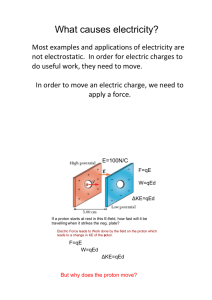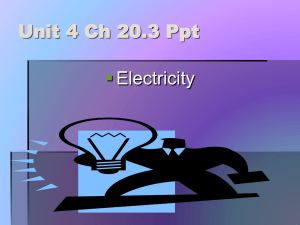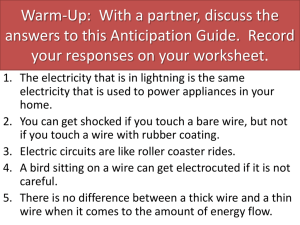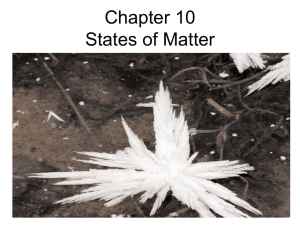File
advertisement
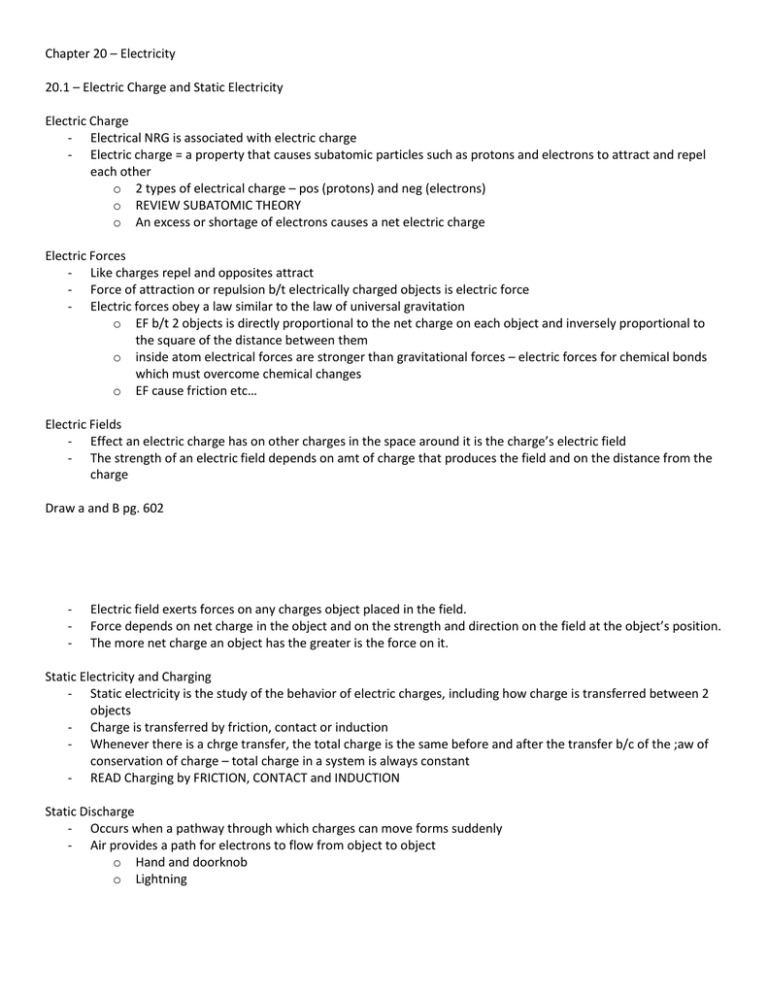
Chapter 20 – Electricity 20.1 – Electric Charge and Static Electricity Electric Charge - Electrical NRG is associated with electric charge - Electric charge = a property that causes subatomic particles such as protons and electrons to attract and repel each other o 2 types of electrical charge – pos (protons) and neg (electrons) o REVIEW SUBATOMIC THEORY o An excess or shortage of electrons causes a net electric charge Electric Forces - Like charges repel and opposites attract - Force of attraction or repulsion b/t electrically charged objects is electric force - Electric forces obey a law similar to the law of universal gravitation o EF b/t 2 objects is directly proportional to the net charge on each object and inversely proportional to the square of the distance between them o inside atom electrical forces are stronger than gravitational forces – electric forces for chemical bonds which must overcome chemical changes o EF cause friction etc… Electric Fields - Effect an electric charge has on other charges in the space around it is the charge’s electric field - The strength of an electric field depends on amt of charge that produces the field and on the distance from the charge Draw a and B pg. 602 - Electric field exerts forces on any charges object placed in the field. Force depends on net charge in the object and on the strength and direction on the field at the object’s position. The more net charge an object has the greater is the force on it. Static Electricity and Charging - Static electricity is the study of the behavior of electric charges, including how charge is transferred between 2 objects - Charge is transferred by friction, contact or induction - Whenever there is a chrge transfer, the total charge is the same before and after the transfer b/c of the ;aw of conservation of charge – total charge in a system is always constant - READ Charging by FRICTION, CONTACT and INDUCTION Static Discharge - Occurs when a pathway through which charges can move forms suddenly - Air provides a path for electrons to flow from object to object o Hand and doorknob o Lightning 20.2 – electric Current and Ohm’s Law Electric Current - Continuous flow of electric charge - SI unit = ampere (A) or amp – 1 coulomb/sec - 2 types o Direct current (DC) – charge flows in only one direction – flashlights etc.. o Alternating current (AC) – charge regularly reverses direction – home Conductors and Insulators - Electrical conductor – material through which a charge can flow easily - Electrical insulator – material through which a charge cannot flow easily - Rubber coating around electrical wires helps keep the currents in place - Remember metals are made up of ion lattices with nearly free electrons that are able to conduct charge - Good conductors – metals (Cu and Au) - Good insulators – wood, plastic, air Resistance - When e-s move through a conduction wire they collide with more e-s and ions - Collisions kinetic nrg thermal nrg - b/c less nrg is available to move e-s through the wire the current is reduced. - Resistance – opposition to the flow of charges in a material. SI unit = ohm o Affected by material’s thickness, length and temp. o How? Thicker – less resistance, longer – more resistance, temp inc – resistance INC b/c more collisions o Think about cooling a conductor… Superconductor – material that has almost 0 resistance when cooled to low temps Best around 138 K Voltage - In order for charge to flow in a conduction wire, the wire must be connected in a complete loop that includes a source of electrical NRG - Potential Difference o Charge flows spontaneously from higher to lower potential NRG o PE depends on position in electric field o Potential difference – the difference in electrical potential NRG b/t 2 places in an electric field o Measured in joules/coulomb or VOLTS – therefore PE also called voltage - Voltage sources o 3 common sources include batteries, solar cells and generators Battery – converst chemical NRG to electrical NRG PE ( voltage) is maintained across the terminals that connect to wires in a circuit Ohm’s Law - Unit of resistance - Voltage is not the same every where in a circuit - Resistance reduces voltage - Ohm’s Law o Voltage (V) = current (I) x resistance (R) or I = V/R o Current in amperes, resistance in ohms, voltage in volts What is the voltage if the resistance is 3 ohms and the current is 3 amps? o INC voltage INC current. 20.3 – Electric Circuits Circuit diagrams - Electric circuit is a complete path through which charge can flow - Circuit diagrams use symbols to represent parts of a circuit, including a source of electrical NRG and devices that are run by electrical NRG o Shows one or more complete paths charge can flow o Open switch – circuit is not a complete loop, current stops – open circuit o Closed switch – circuit is a complete loop, current flows – closed circuit - Remember, direction a current is defined as the direction in which + and – charges would flow. E-s flow in the opposite direction Series Circuits - Charge has only one path to flow - If one element in a series circuit stops working, none work Parallel Circuits - Electric circuit w/ 2 or more paths through which charges can flow - If one element stops working, can still operate Power and NRG calculations - The rate at which electrical NRG is converted to another form of NRG is electric power - J/s or W or kW - Electric power = I (amps) x V (voltage) …….voltage by current An electric oven is conenctedc to a 240 – volt line and it uses 34 amps of current. What is the power used by the oven? P = I x V = 34 x 240 = 8200 W DMP pg. 611 1-3 - Electrical NRG is power multiplied by time E=Pxt Electrical Safety - Correct wiring, fuses, circuit breakers, insulation and grounded plugs make electrical NRG safe to use. - READ HOME SAFETY, PERSONAL SAFETY



